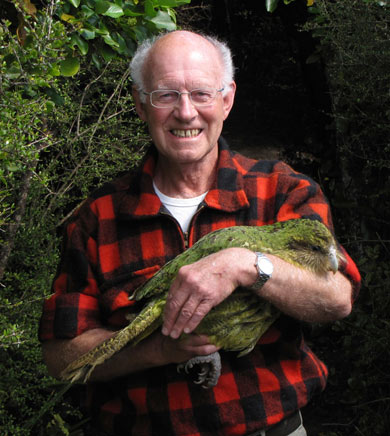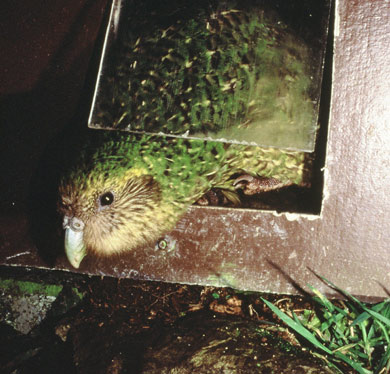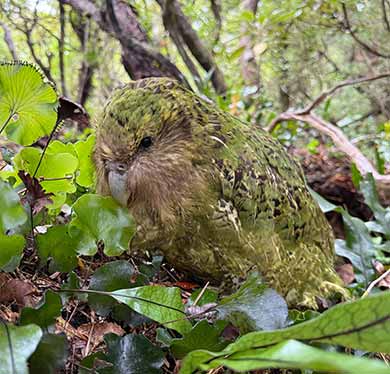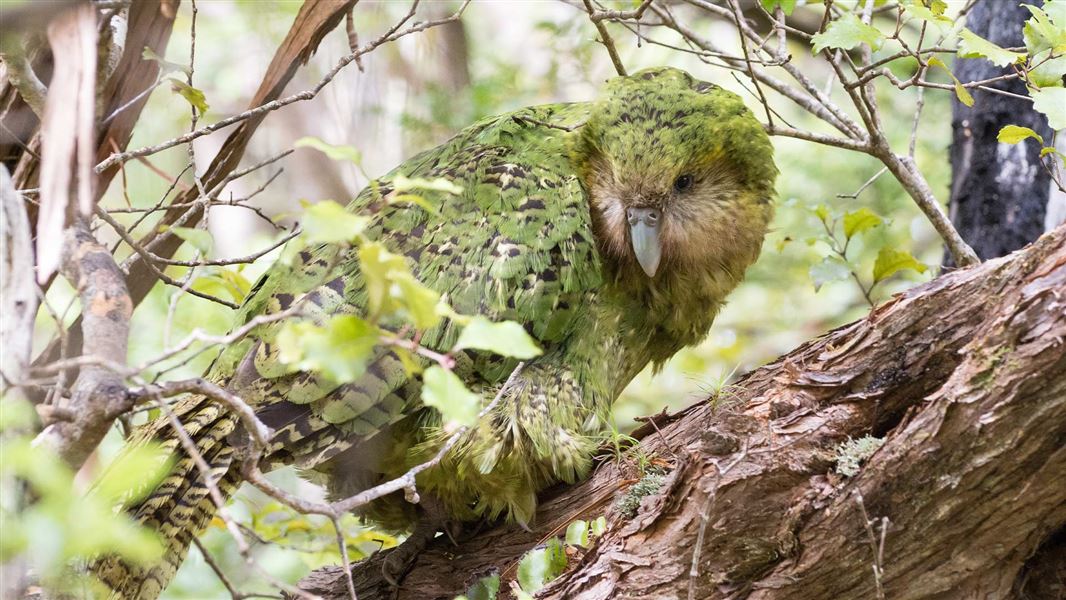Richard Henry

Don Merton holds kākāpō Richard Henry
Image: Errol Nye | DOC
Discovered: Fiordland, 1975
Died: 2010
Conservationists found Richard Henry living in Fiordland, more than 1,000 m above sea level. His home was bordered by the sheer walls of the Gulliver Valley.
He was the last surviving Fiordland bird, so his DNA was crucial in ensuring genetic diversity in the kākāpō population. In 1998, Richard Henry fathered three chicks to Flossie on Maud Island.
He seemed to boom in a different dialect to the Stewart Island/Rakiura birds. He made single, widely-spaced booms and he didn’t ching. His colouring was different too – brighter green with bold yellow markings.
He seemed to have been in semi-retirement towards the end – he didn’t boom during his last ten years. He was thought to be around 80 years old when he died.
Richard Henry was named after the pioneer New Zealand conservationist who first tried to safeguard kākāpō from predators more than 100 years ago.
Hoki

Kākāpō Hoki uses a door in her pen. She now lives in the wild
Image: Gideon Climo | DOC
Hatched: Whenua Hou 1992
Died: 2019
Hoki was the first kākāpō to be partially reared in captivity.
Natural food supplies failed when Hoki was five weeks old, so her mother Zephyr couldn't feed her enough food. She was hand reared for eight weeks at Auckland Zoo, then grew up in captivity on Maud Island for five years.
She provided us with a special opportunity to observe kākāpō habits and behaviour and we soon learned how intelligent and entertaining kākāpō can be. Hoki created her own amusement, springing up and down on branches, and often playing with our buttons and zippers. She also provided insights into kākāpō biology and development. We watched her learning to call and display as she would in the wild.
When Hoki returned to the wild she could be bad-tempered, perhaps because she became used to having her own way in captivity. She would wriggle and grumble and bite while being held. But she also had a soft side, occasionally coming straight out to feed from her hopper while volunteers were still close by.
Hoki bred for the first time during the 2002 breeding season. She laid one egg, which died early in incubation. She was given a foster egg to care for and, with a little help, successfully reared a healthy chick.
She didn’t breed in 2005 or 2008. In 2009, and 2019 she was given the opportunity to foster chicks after laying infertile eggs. Sadly, Hoki passed away in April 2019 following a serious infection.
Solstice

Solstice
Image: DOC
Discovered: Rakiura 1997
Died: 2025
Solstice was discovered on 21 June 1997, the winter solstice, and was named in honour of the date. She was found at Healey’s Creek by Murray Willans and his dog Penny, alongside Phred Dobbins and Grant Harper.
As the last kākāpō found on Rakiura Stewart Island, Solstice holds a special place in the recovery story of her species. It had been five years since a kākāpō was last located on the island, and she was the only founder with no first-order relatives from Rakiura, making her genetics valuable to the population. Soon after her discovery, Solstice was relocated to Whenua Hou/Codfish Island, where she became the 'matriarch of the Celestial dynasty'. Many of her descendants carry celestial-themed names as a nod to her legacy.
In 2002, she laid three fertile eggs after mating with Felix, though sadly, all embryos died early in incubation. Then, In 2009 she was part of a pioneering artificial insemination effort. After mating with Felix again, we took the opportunity to intervene, inseminating her with fresh sperm from three other males: Arab, Smoko, and Stumpy. The three eggs she laid were the first ever fertilised through artificial insemination in kākāpō. Two were Smoko's and one was Arab's. One embryo failed early, and Arab's chick died before hatching. The surviving chick, female Rā, was hand-reared and went on to produce four chicks of her own before her untimely death in 2022.
In 2011, Solstice had three chicks: two females, Stella and Ihi (Māori for 'ray of sun'), and a male, Kōmaru (Māori for 'sun'). Their father was Waynebo, another founder from Rakiura, who died the following summer. Solstice mated with Felix again in 2016 but laid four infertile eggs. Then in 2019, she nested an impressive three times, laying eight eggs. Unfortunately, most were infertile - likely due to her choice of mate, Stumpy, an inexperienced hand-reared male - and the only fertile egg failed to develop. The 2022 breeding season brought better luck when Solstice mated with Gulliver, a male carrying important Fiordland genetics. She laid three eggs, two of which hatched, producing Valerie and Manakouri.
Solstice was known as one of the largest female kākāpō, often weighing around 2 kg even without supplementary feeding. Despite producing many eggs over the years, she struggled to rear chicks herself. This was possibly a result of her early life on Rakiura, where nest predation by rats was a serious threat.
In 2024 Solstice became the first ever 'special edition' adoption kākāpō, helping raise funds and awareness for the recovery programme. Solstice died in 2025 from an infection after battling cloacitis.
Other key kākāpō
Read more kākāpō profiles:
